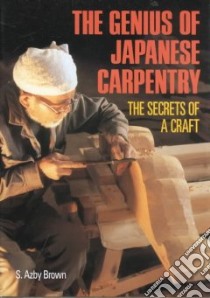The Genius of Japanese Carpentry - 9784770019783
Un libro in lingua di Brown S. Azby edito da Kodansha Amer Inc, 1995
- € 24.90
- Il prezzo è variabile in funzione del cambio della valuta d’origine
0ver a thousand years ago in Nara, Japan, anonymous carpenters erected a number of temples and pagodas for a newly founded Buddhist monastery known as Yakushiji. Not only is one of those pagodas still standing today, but also surviving are the dedication to quality and the technical skill of its builders as seen in the work of modern-day craftsmen. The Genius of Japanese Carpentry focuses on such practicing carpenters, who combine in their work the timeless past and the living present.
What precisely is a Buddhist temple, what a temple carpenter, and what relationship do they have to Japanese woodworkers and carpenters in general? S. Azby Brown raises and answers these questions before taking up the subject that lies at the heart of the book: the construction of the Picture Hall, one of the temples lying within a sub-compound of the Yakushiji monastery. Founded in the eighth century and subject over time to the depredations of fire and warfare, the Yakushiji is now in the midst of a complete renovation that will, by the year 2030, restore its original appearance. As one part of this project, the construction of the Picture Hall has now been completed, employing the methods, the architectural style, and to a large extent the technology of its Japanese historical predecessors.
From the day work commenced on the Picture Hall to the day it was finished, the author was at the site, camera in hand, recording its step-by-step erection: the selection of wood, the fabrication of parts, the detailing, the joint-making, the laying of the foundations, the pillars and beams going into place, installment of rafters and struts, the laying of the roof and roof-tiles, and, finally, the holding of the festive ridge-beam ceremony. In addition to documentary photographs, the book is remarkable for the author's drawings, based on the plans of the master carpenter himself. The combination of photos and drawings so clarifies the process of erection that the ambitious reader might imagine, for one heady moment, that he or she might undertake the building of just such a temple if only provided with the proper tools. While far from the truth, this illusion is eloquent testimony to the lucidity of the author's presentation. While it is thus the construction process itself that forms the center of the book, another important element, the human element, is never slighted. The carpenters themselves are continuously present, patiently going about their work, concentrating on the job at hand. It is perhaps from their example, as much as from the description of the stages of construction, that the modern reader will derive inspiration, discovering a common bond of sympathy that bridges both time and cultural boundaries.
Informazioni bibliografiche
- Titolo del Libro in lingua: The Genius of Japanese Carpentry
- Sottotitolo: The Secrets of a Craft
- Lingua: English
- Autore: Brown S. Azby
- Editore: Kodansha Amer Inc
- Collana: Kodansha Amer Inc (Paperback)
- Data di Pubblicazione: 15 Settembre '95
- Genere: ARCHITECTURE
- Dimensioni mm: 254 x 184 x 12
- ISBN-10: 4770019785
- EAN-13: 9784770019783


